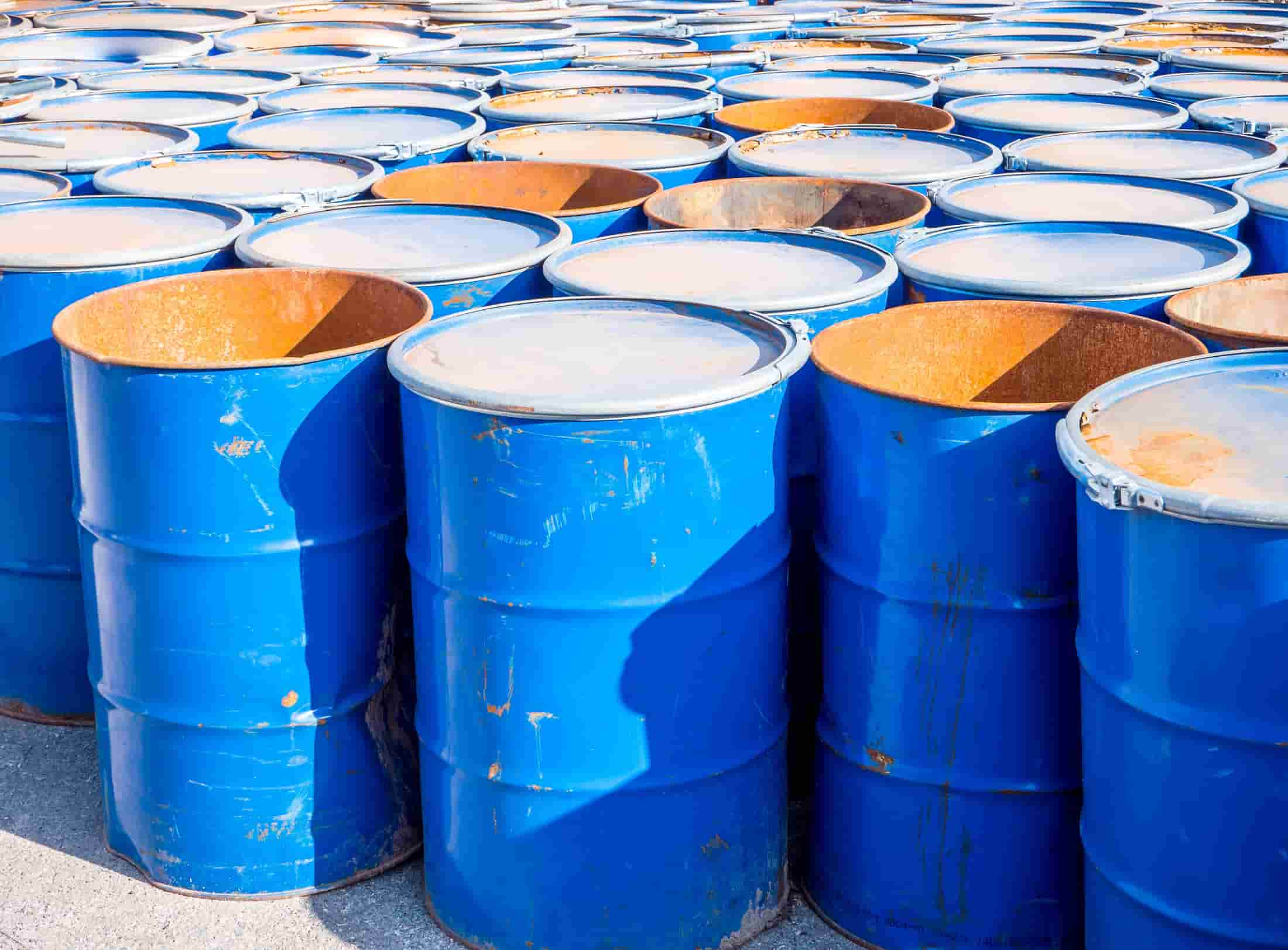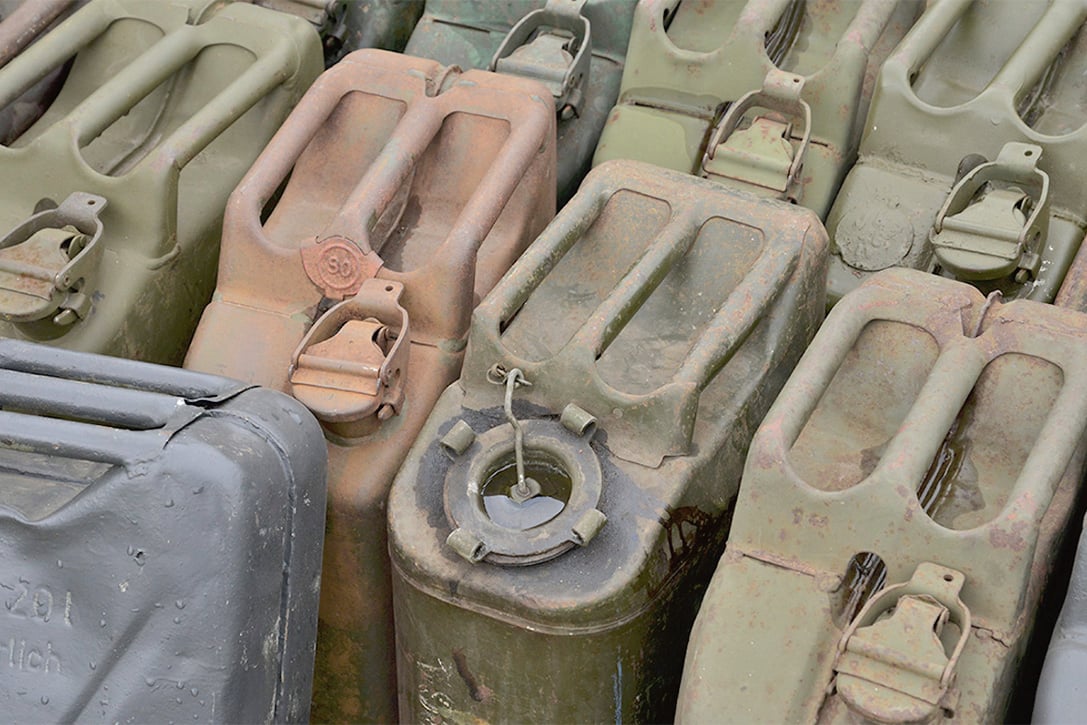Did you know that common flammable liquids, such as petrol, diesel fuel, kerosene and turps can be ignited by static electricity? And we’re talking about static electricity from simple everyday items — like the remote control from a keyless entry system, the courtesy light inside a vehicle or even static charge from certain clothing. In today’s blog, we’ll be discussing flammable liquids safety when using jerrycans and portable chemical containers — and highlighting some of the key hazards and compliance issues.
How Do You Avoid Hazards When Decanting and Transferring Flammable Liquids?
Flammable liquids must be carefully handled during the decanting and transferral process to reduce the risk of human harm, fire and explosion.
Across Australia, and the globe, there have a been many large fires and explosions caused by workers using jerrycans and other portable chemical containers incorrectly. It’s important to remember that, in many instances, people were seriously injured, vehicles destroyed and buildings totally damaged.
While decanting and transferring flammable liquids is an everyday occurrence for many workers, it must be carried out in a safe and compliant manner to reduce risk.
Using real-life incidences of flammable liquids accidents, we’ll be detailing what you should do (and what you should avoid) when working with any type of Class 3 liquid.
Only Use Approved Flammable Liquids Containers
Two workers were refuelling compressors using a jerrycan fitted with a secondary funnel. The funnel didn’t create a full seal and fuel spilled onto the compressor’s hot muffler, then ignited. One worker suffered burns to the arms and face as well as smoke inhalation.
As the above incident has highlighted, spilled flammable liquids can lead to horrific workplace accidents. To avoid situations such as this occurring, flammable liquids must only be stored in approved chemical containers that have proper seals.
It’s equally important to ensure that the decanting equipment you use, such as funnels, pourers and strainers, are also made from suitable materials.

When working with flammable liquids, make sure that the equipment you’re using is constructed from suitable materials.
You must consider the following safety points when decanting flammable liquids:
- When purchasing jerrycans and other portable containers look for markings that indicate the container has been manufactured to Australian Standard AS/NZS2906 — Fuel containers - Portable - Plastics and metal or an equivalent.
- Make sure pouring equipment fits the container sizes perfectly without leaking.
- Allow machines to cool down before re-fuelling as the heat can act as an ignition source.
IMPORTANT: Plastic oil containers, soft drink bottles, and other cheap plastics are not suitable for storing flammable liquids.
Avoid Ignition Sources When Filling Jerrycans and Fuel Containers
An Australian worker was at a service station refilling 20 litre fuel containers located in the back of a 4WD. The flammable vapours ignited and caused a major fire which destroyed 3 vehicles, seriously injured the worker and caused critical damage to the service station.
When jerrycans and other fuel containers are being refilled, they are vulnerable to ignition sources — especially static electricity.

If staff are refilling portable fuel containers with flammable liquids, they must be careful to avoid static electricity and ignition sources.
The following precautions are recommended when refilling jerrycans and containers with fuel:
- Put jerrycans and portable fuel containers on the ground for refilling — never leave them in the car or even the back of the ute.
- Remove the lid or cap slowly to release vapours — point the opening away from the face and body of workers.
- While refilling, keep one hand on the fuel container to reduce static build-up and discharge — use an earthing strap if available.
Reducing Risk When Refilling at a Service Station
When staff are refilling containers at a petrol station, make sure that these basic procedures are followed to reduce risk of ignition:
- Don’t leave containers of fuel in the sun, anywhere hot, or near ignition sources.
- Replace the lid and ensure it creates a full seal before putting the container back in the vehicle.
- Don’t leave jerrycans and portable fuel containers in the boot of a car — shaking can cause petrol to vaporise and expand. The vapours may ignite when the cap is removed.
Follow Safety Procedures When Re-Fuelling Machines with Portable Containers
An Australian worker suffered serious burns while trying to re-fuel a compressor in the back of a ute. The jerrycan ignited without warning and the ignition source was never able to be established.
Decanting and transferring fuel is always a hazardous activity, so have strict operating procedures in place — making sure workers are properly trained to identify and eliminate any hazards.
Some key recommendations include:
- Never attempt to refuel compressors and other machinery while they are running.
- Take the machine away from the refuelling area before restarting.
- Ensure all ignition sources are at least 3-5 metres away.
- Take care not to overfill.
Store Jerrycans and Fuel Containers in a Safe, Compliant Manner
A worker was using a grinder when sparks ignited a nearby container of fuel that had been left open. When he tried to extinguish the fire, he slipped on the concrete floor and fell into the fire. Suffering second and third degree burns to his limbs, the worker was hospitalised for 11 days.
Jerrycans and other portable fuel containers create unnecessary fire and explosion hazards when they are left lying around the job site or stored incorrectly.
It’s critically important to:
- Immediately replace the cap or seal whenever the jerrycan or fuel container is not being used.
- Check to ensure the lid or cap creates a liquid tight seal.
- Wipe down containers and remove chemical residue before putting away.
- Store jerrycans and fuel containers in a Class 3 Flammable Liquids cabinet that has been manufactured to Australian Standard AS 1940:2017 –- The storage and handling of flammable and combustible liquids.
- Inspect the containers regularly for signs of leaks, corrosion, cracking and dents.
- Don’t allow ignition sources to brought within 3-5 metres of the flammable liquid’s cabinet.
What to do in the Event of an Accident
If you find yourself in a position where flammable liquids ignite, you must act quickly. Make sure you
- Stop, drop and roll if clothing catches on fire.
- Alert petrol station attendants and fire services.
- Don’t move the flammable liquids container or equipment as this may increase risk to people, property and the environment.
- Utilise a fire extinguisher or fire blanket, if safe to do so.
- Don’t use water on a flammable liquids fire as it will not extinguish the blaze. Water may make the fire worse by spreading the flammable liquid.
To avoid such incidences occurring, you must take a precautionary approach to the decanting and transferring of flammable liquids.

To maintain flammable liquids safety, invest in training for your workers so they know how to safely decant and transfer liquids.
Some basic rules for the decanting or transferral of flammable liquids include:
- Only allow trained staff (under supervision, where appropriate) to handle flammable liquids.
- Choose compliant flammable liquids containers manufactured to AS/NZS 2906.
- Identify and isolate any type of ignition source from the area
- If re-fuelling at a service station, ensure you adhere to all safety guidelines.
- Select the appropriate decanting devices.
- Keep containers wiped down, free of residue and secured with a lid.
- Store containers in upright positions in a compliant store or cabinet.
- Avoid heat and sunlight during the process.
- Only fill portable fuel containers on the ground – never inside a vehicle, ute tray or trailer.
- Reduce the risk of static electricity by using earthing straps, keeping one hand on the container while re-fuelling and/or grounding all equipment.
- If PPE is required, ensure that the clothing won’t generate static electricity and the gloves are chemically resistant.
- Meet the requirements of AS 1940:2017 by clearly marking flammable liquid stores and containers with the correct signage and install emergency decontamination equipment including eye wash facilities and/or safety showers in appropriate work areas.
Flammable Liquid Dispensing Stations
To reduce risk during the decanting and transferral of flammable liquids, you may choose to invest in a flammable liquids dispensing station or an outdoor IBC store which can be used for chemical decanting.
Storemasta Lube Stations offer a seamless dispensing and decanting solution for workplaces or remote sites. Featuring high grade flexible hose with quick release cam lock fittings, hose fouling prevention, ventilators for air filtration, lubrication dispensing equipment, compliant bunds and an OH&S friendly design, such innovations can create a safer environment for organisations that rely on flammable liquids.
Alternatively, for the decanting of flammable liquids in the outdoor environment, choose a Flammable Liquid 2 IBC Decanting store which offers all the features of our outdoor chemical storage containers, plus extra headroom for the use of decanting equipment.
Are You Decanting and Transferring Flammable Liquids?
As we’ve explained in our blog, the incorrect use of jerrycans and portable containers can lead to dangerous workplace incidences such as flammable fires, explosions, property damage, human harm and even fatalities. If your staff are decanting and transferring flammable liquids, make sure they only use approved jerrycans and portable containers for petrol and other flammable liquids. And remember — never decant or refill the containers from the back of a vehicle. Would you like more information and expert advice on maintaining flammable liquids safety and compliance? Our eBook, Essential Considerations When Storing Flammable Liquids Indoors, will help you better understand the risks associated with flammable liquids. We’ll also introduce you to our 4-step risk control methodology that you can easily apply to your own organisation, so you can meet your compliance obligations. Download this helpful guide and read it today.
Joining the team as a Dangerous Goods Storage Consultant, Melissa Hampton became Storemasta's Marketing Manager in late 2021. With extensive knowledge and experience in chemical compliance, Melissa is responsible for leading the Marketing team and helping shape their marketing strategy. In her spare time, you can find Melissa hiking, swimming and enjoying the great outdoors in beautiful north-west Tasmania.
